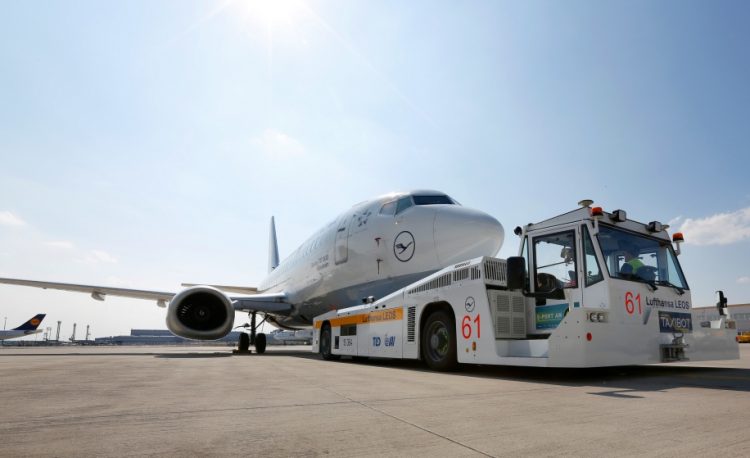Aircraft Tractors Driven from the Cockpit Save Thousands of Tons of Fuel

TaxiBots are real powerhouses — the narrow-body model has around 500 kilowatts of drive output (approximately 800 hp). The TaxiBot’s driven by electric motors. Siemens supplies the tractors with powertrains. Image: TaxiBot in action at Frankfurt Airport.
Until now, airplanes have had to use their own turbines to cover this stretch. However, this is very uneconomical, as taxiing consumes up to one metric ton of fuel, depending on the airplane’s size and the distance covered. It is much more efficient to use a diesel-electric towing tractor that attaches itself to the nose wheel and pulls the airplane to the runway. As a result, an aircraft doesn’t have to turn on its engines until after it arrives at the runway.
After conducting extensive tests, Lufthansa now regularly uses such taxiing robots or TaxiBots at Frankfurt International Airport. According to the airline, the tractors enable it to save around 11,000 metric tons of fuel each year at Frankfurt Airport alone. TaxiBots are the result of a joint project between Siemens, the French TLD Group, Israel Aerospace Industries, and Lufthansa LEOS.
TaxiBots not only cut fuel consumption and emissions, they also reduce the strain on aircraft engines, thus extending their maintenance intervals. In addition, they aren’t as noisy as jet turbines. Current TaxiBots tow narrow-body (i.e. single-aisle) airliners such as the Airbus A320 and the Boeing 737. These tractors create only half as much noise as a taxiing airplane.
Including its own energy consumption, a Narrow-Body TaxiBot can save up to 150 kilograms of fuel on each taxiing mission. Trials with Wide-Body TaxiBots for airliners with two aisles, such as the Airbus A380 and the Boeing 747-400, are scheduled to begin soon at Chateauroux Airport in France. One such TaxiBot can save up to one metric ton of fuel when it tows a wide-body jet, which can weigh up to 600 metric tons.
Tractors Powered by Diesel-Electric Hybrid Drives
TaxiBots are real powerhouses — the narrow-body model has around 500 kilowatts of drive output (approximately 800 hp), while a Wide-Body model generates about 1 megawatt (over 1,350 hp). The TaxiBot’s four wheel pairs — for a Narrow-Bodyvehicle — or six wheel pairs — for a Wide-Bodyvehicle— is driven by electric motors. Every individual wheel of the Wide-Body model has its own drive motor.
Siemens supplies the tractors with powertrains, which consist of generators, electric motors, converters, electronics, and software. Although many of the components are based on those of the ELFA hybrid drive system for buses, they were specially developed or adapted for the needs of TaxiBots, which, among other things, require high torques and short response times.
For safety reasons, the system has a redundant design, which means that two diesel engines drive two generators for electricity production. The converters turn the electricity into a form usable by the electric motors. Depending on the model in question, a tractor can be equipped with either six or 16 converters. Wide-Body TaxiBot systems can even be separated into three pieces in the event of a fault. This ensures that two thirds of the drive system will work. In case of a fault such as a short circuit, the electronics developed by Siemens automatically switch off one third of the drive system.
The wheel module that contains the motors for each wheel pair is also a completely new development. Moreover, Siemens engineers have optimized Wide-Body TaxiBot technology by using permanent-magnet electric motors, which operate even more efficiently than conventional asynchronous machines. What’s more, the motors are completely integrated into the wheel module housings. Another new feature is that a TaxiBot can control the electric motor of each of its wheels separately.
This is an advantage when the vehicle turns in place or travels slowly, for example, because a great deal of force is required to turn the wheels under an airliner’s massive load. To achieve this, the Wide-Body TaxiBot can apply different amounts of force to the two wheels of a pair or drive them in opposite directions.
An important consideration during the development of TaxiBots was that pilots would continue to have sole control over an airplane, as required by law. For example, a tractor would be unable to properly brake a moving airliner weighing hundreds of tons.
When a pilot brakes an airplane via its main landing gear, the TaxiBot responds within 130 milliseconds and brakes as well so that the nose wheel isn’t subject to any strain. A plane’s nose wheel is attached to a TaxiBot by means of a special interface mechanism that registers all of the pilot’s steering and braking maneuvers, which it translates into commands for the tractor’s wheels. The software for controlling the wheels also comes from Siemens.
Norbert Aschenbrenner
Mr. Dr Norbert Aschenbrenner
Editorial Office
Siemens AG
norbert.aschenbrenner@siemens.com
Mr. Florian Martini
Press contact
Siemens AG
florian.martini@siemens.com
Media Contact
More Information:
http://www.siemens.comAll latest news from the category: Power and Electrical Engineering
This topic covers issues related to energy generation, conversion, transportation and consumption and how the industry is addressing the challenge of energy efficiency in general.
innovations-report provides in-depth and informative reports and articles on subjects ranging from wind energy, fuel cell technology, solar energy, geothermal energy, petroleum, gas, nuclear engineering, alternative energy and energy efficiency to fusion, hydrogen and superconductor technologies.
Newest articles

Properties of new materials for microchips
… can now be measured well. Reseachers of Delft University of Technology demonstrated measuring performance properties of ultrathin silicon membranes. Making ever smaller and more powerful chips requires new ultrathin…

Floating solar’s potential
… to support sustainable development by addressing climate, water, and energy goals holistically. A new study published this week in Nature Energy raises the potential for floating solar photovoltaics (FPV)…

Skyrmions move at record speeds
… a step towards the computing of the future. An international research team led by scientists from the CNRS1 has discovered that the magnetic nanobubbles2 known as skyrmions can be…





















